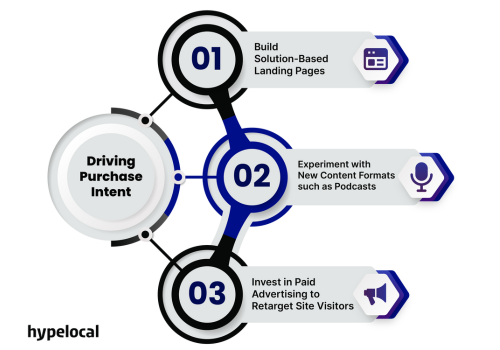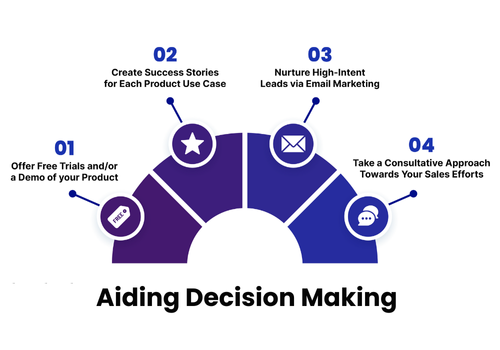
In a world where the average consumer is inundated with more information than they can digest, the entire ethos of marketing has evolved tremendously. As your potential customers have grown smarter, their expectations have changed significantly. They no longer chase quick fixes, but demand value. They no longer judge products or services alone, but also the quality of experiences they receive.
As a marketer competing for the ever-decreasing consumer attention and limited mind space, how do you drive sustainable long-term business growth…? By looking beyond running a viral campaign, gathering quick form fills, or meeting monthly MQL targets, and focusing on the bigger picture - driving long-term brand affinity via demand generation marketing.
The cornerstone of demand generation marketing is offering real value, solving actual customer problems, creating genuine awareness, and sharing knowledge at large, to ultimately fulfill business goals.
In this blog, we shall deep dive into the world of demand generation marketing and how it is increasingly effective in driving long-term business growth, especially given today’s market dynamics.
What is Demand Generation Marketing?
Demand generation marketing encompasses the entire lifecycle of marketing activities that work cohesively to create awareness about a particular brand or product, by meaningfully engaging prospects across multiple touchpoints and over an extended period of time.
Demand generation marketing is a solution-oriented, long and steady approach towards reaching your target audience with valuable content that interests them, engages them constructively, and ultimately, helps spur interest in your offerings.
From the strategy to execution, the concept of demand generation marketing is rather nuanced, and not linear.
Demand generation marketing efforts span across:
- Multiple marketing and sales campaigns
- Various touch points in the customer journey
- Numerous content resources
- At least a few weeks.
The common aim of all demand generation marketing campaigns is to contribute towards generating consistent and steady demand for the business in the long run by forming meaningful customer relationships, driven by education and awareness.
As opposed to some other marketing functions, the goal of demand generation isn’t just generating X leads in a particular month, but generating a persistent and dependable pipeline of leads month-over-month, that are nurtured over time to convert and drive the long-term revenue numbers.
Let’s take Mary, for example. She just quit her job as a graphic designer to pursue freelancing full-time and has recently signed a few pilot projects with a couple of clients. While she’s got every nitty-gritty detail of her new career move figured out, she couldn’t be more intimidated by the entire process of managing invoices and payments from multiple clients.
She decided to look it up and found a comprehensive guide titled “The Beginner’s Guide to Invoicing as a Freelancer”. She downloaded the included infographic, bookmarked the blog, and referred to it later to get all her questions answered. However, reading the guide left her with a few more questions than she initially had. Since the quality of content in the guide impressed Mary and convinced her that it came from expertise, she decided to reach out to the company that had published the blog, which turned out to be the maker of invoicing software for small businesses.
She got all her questions answered by the sales team regarding how she can set-up and manage a seamless invoicing and payments system for her new business. The salesperson suggested Mary give their software a try, but she realized she wasn’t ready to invest in a paid tool just yet.
After that interaction, Mary was really happy with the experience she had with this company, without having shown any interest in becoming a paid customer. She even received a bi-weekly email from them that shared valuable content resources just like the guide she first read.
From the high-quality content resource and free consultation to nurture emails and more, all interactions that Mary had with this business are a form of demand generation marketing. The goal wasn’t to immediately sell to Mary and convert her into a paying customer, but to educate her over time and offer subject matter expertise that would lead her to purchase in the long-run.
How to Build a Winning Demand Generation Strategy
Since demand generation strategy does not lie in any one specific stage of the marketing funnel, but is focused on driving results from each stage and touchpoint in the customer journey; your campaigns too must be aligned with the funnel in order to help you achieve your common marketing goal.
While we’ll delve deeper into what those campaigns should be in the next section, let’s first understand the three funnel stages which will help you to bucket your specific demand generation marketing activities.
Generating Awareness (Top of the Funnel)
At this stage of demand generation marketing, you want to think about your target audience at-large and build an all-encompassing strategy to create awareness and interest. Your aim here is to create a space for your brand by getting your audience interested in what you have to say, generating engagement, and participating in ongoing conversations.
This can only be done by taking a solution-centric approach towards your strategy - offering real value that illustrates your expertise in the category and establishes your brand’s authority. Focus the least on your product and the most on establishing an omnichannel presence and talking about solutions that your audience is looking for.
Focus the least on your product and the most on establishing an omnichannel presence and talking about solutions that your audience is looking for.
Driving Purchase Intent and Consideration (Middle of the Funnel)
Once a potential customer expresses interest in your product (or even in your content in general) you want to slowly start marketing to them about the solutions that you can offer based on their potential requirements.
Your campaigns and tactics here must be targeted towards driving purchase intent and answering more in-depth questions about the specific problems you solve. This is the stage where your prospects are in deep research mode and want to get as much information as they can before they make their decision. As a marketer, your best shot at getting them to convert is by making their journey smoother and shorter by leveraging your demand generation strategy.
Aiding Decision-Making (Bottom of the Funnel)
This is where you put your consultant hat on and guide prospects through the final stage of the demand generation marketing funnel. The idea here is to offer as much guidance and resources as you can to simplify their decision-making process and turn it in your favor. Once a prospect has entered the sales pipeline or displayed purchase intent, you need to start thinking about how well you can personalize your solutions for a particular customer and package it to them.
The best tip here would be to utilize as much data as you’ve collected about each prospect and use it to guide your demand gen efforts so you are not shooting in the dark, but can tailor your campaigns to drive fruitful results.
Demand Generation Tactics to Set your Strategy in Motion
To kick off your demand generation strategy, try to use as many tactics as possible to figure out what resonates best with your audience. Here are some tried and tested demand generation tactics that will help you achieve your goals for each stage of the marketing funnel:
Generating Awareness
1. Focus on Social Media Marketing
No matter what your exact audience segment is, it’s safe to assume that they have an active presence on one social platform or the other. Social media marketing, therefore, cannot be an afterthought or secondary strategy, but needs a primary channel where you consistently engage with your audience. To get started with building a social marketing strategy,
- Invest in a social listening tool to understand what your competitors and audience are talking about so you can partake in those conversations and create content around it.
- Create a social calendar for daily or weekly content that you want to share with your audience.
- Create a topical calendar to plan out the content you share on special days, events, and festivals.
- Make sure your content is engaging and interactive - include a mix of polls, quizzes, user-generated content, and giveaways in your strategy.
- Stay on top of every interaction - respond to comments and messages timely, share your opinions actively, and keep the engagement going at all times.
If you’re looking to build an engaging social media marketing strategy but not sure where to get started, we’d love to offer you a free strategy session to help you chart out a winning roadmap.
2. Create an SEO-Driven Content Marketing Strategy
Content is king, sure; but you cannot unlock its full potential without optimizing your content for search engines. To generate awareness and interest about your brand, you need to create a highly-targeted, SEO-driven content strategy to publish educational and informative content that can be easily discovered by your target audience. To get started:
- Invest in an SEO tool such as SEMrush or Ahrefs to do your keyword research and drill down into high-volume search phrases that your audience uses
- Create a content strategy centered around the shortlisted keywords and your preliminary research
- Be sure to include a variety of content formats so you can experiment and find out what works best for your audience (blogs, guides, success stories, etc)
- Ensure your content ideas are solution-oriented and insights-driven, and not promotional; to educate your audience and share your unique perspective
3. Set Aside a Budget for Paid Advertising
Paid advertising is that necessary evil of your demand generation strategy you need to drive traffic to your site and generate awareness for your brand. When getting started, do your keyword research comprehensively to come up with both - generic and niche keywords that are commonly used by your target audience. Target both categories of keywords equally to drive high volume as well as high-intent visitors from search engines to your site.
When it comes to social media and other platforms such as Youtube where your TG has an active presence, use paid advertising to reach and engage them as part of their browsing experience. Target your ads based on demographic and psychographic factors of your ideal audience persona, and also their likes, interests, and preferences.
To shortlist assets to promote via top-of-the-funnel paid advertising, choose ones that are likely to pique interest and get clicks, such as:
- Your best-performing gated content resources
- High-converting solution-based landing pages
- Descriptive feature and product pages
Looking for more insight? Grab a free strategy session with our team to talk about your goals and how you can launch a winning paid advertising program.
4. Create and Promote Research-Based Long-Form Content
While SEO content is great to drive traffic to your digital properties, you also want to invest in creating primary research-driven content that has an entirely different purpose of establishing your brand as an authoritative voice in the industry. You can start by creating a quarterly or annual goal of publishing X number of eBooks, reports, or whitepapers on trends in your industry that your potential customers could benefit from learning about. If you aren’t sure where to get started, you can also conduct surveys to learn directly from your audience about what they would like to read.
5. Invest in Event Marketing
Whether in-person or virtual, events are one of the most effective demand generation marketing tactics for you to network with your prospective customers and partners as well as provide a valuable networking platform to them. Try to make your events as engaging and interactive as possible by hosting relevant panel discussions, thought provoking webinars, masterclasses, keynote speeches, and other exciting activities to inspire interesting conversations in your industry.
This is a great opportunity to establish yourself as a thought-leader and innovator in the space. You can also use the stage to launch a few products or talk about them, but keep the overall theme of your event centered around celebrating ground-breaking achievements of inspirational trendsetters, and sharing knowledge and solutions, in general.
Driving Purchase Intent
1. Build Solution-Based Landing Pages
Your landing pages are your elevator pitch, so don’t let them be generic. In order to generate purchase intent, you need your site visitors to understand how your offerings can solve their particular problem, and not any 5 problems. So, build your landing page strategy keeping that in mind, and create landing pages based on the industry-specific or use-case-specific solutions that you provide so visitors can get a glimpse of how your product is the right fit for them.
2. Experiment with New Content Formats such as Podcasts
Prospects who have some degree of interest in the industry that you operate in are likely to be keen on gaining knowledge on the latest happenings, simply to keep up with the trends. Podcasts are a great way to engage with that segment of your audience. It’s an easy-to-consume content format that requires minimal commitment from the listener, and hence is becoming increasingly popular. Start a podcast series where you feature experts in the industry and open a dialogue about the key topics that are likely to move your audience.
3. Invest in Paid Advertising to Retarget Site Visitors
Paid advertising isn’t just effective to help you generate interest, but also retain it by helping you re-engage with your site and app visitors. Any visitor who lands on your site and explores it is likely to be interested in your product or service, and you don’t want to let that interest fade away or lead them to a competitor. Use paid ads to re-engage with these visitors on social channels to remind them of their previous interaction with your brand and offer them an incentive to return - this could be a free eBook download, free trial of your product, or even a discount on your products.
Retargeting isn’t always easy. Book a free strategy session to discuss the best channels and opportunities for your business’ demand generation strategy.

Aiding Decision-Making
1. Offer Free Trials and/or a Demo of your Product
The first step to simplifying a prospect’s decision-making would be to offer them a free trial of your products or services. Experiencing the product first-hand and assessing its capabilities for their specific use case makes it far easier for them to commit to becoming a paying customer.
It allows them to judge whether the product lives up to your claims and their expectations, based on which they will decide if it’s worth the investment. All you can do during this process is make sure all their queries are resolved immediately so the prospect is also able to evaluate your customer service along with the product.
2. Create Success Stories for Each Product Use Case
If you haven’t published any case studies yet, it’s time to start reaching out to your most notable customers to work on documenting their journeys in a way that inspires others to try out your offerings. If you already have a ready repository of case studies, try to reimagine how you’ve been creating them thus far and try to think of how you can repackage them to move prospects and inspire action.
For example, don’t just limit your success stories to the blog/resources section of your site, but repurpose them into sales enablement decks that your representatives can use during pitches or to share as part of email nurtures. And segment your success stories section by industry and other relevant filters so potential customers can quickly access ones that are relevant to them.
Success stories are also a great asset to promote via paid ads to attract buyers who might be interested in learning more about how your services help move critical business metrics. This way, you can improve the readership of your content and make sure the success you have helped your customers achieve reaches as many prospects as possible.
3. Nurture High-Intent Leads via Email Marketing
Once a prospect expresses interest in your products, but is yet to convert, you should not leave them be and expect them to find the motivation to purchase themselves. As a part of your demand generation marketing efforts, you need to guide them through the process, while answering any and all questions they might have before they make a commitment.
To do so, create a nurture email drip to periodically and constructively engage with prospects by sharing your high-performing content pieces, primary research reports, industry trends and best practices, links to self-help resources, with an option to reach out to your sales rep if they need further help.
4. Take a Consultative Approach Towards Your Sales Efforts
Demand generation marketing encompasses every touch point in the customer journey, including early sales motions. Just like Mary in the example from above, your customers also expect to be guided first and not just sold to. They appreciate when a sales representative takes a consultative approach and assists the customer in solving their problem, instead of directly forcing their product on them.
Therefore, as much as possible, encourage your sales team to handhold prospects into finding the most suitable solutions to their problems, while suggesting the best course of action depending on their requirements. And, if there isn’t a fit for your product or service, always ensure that your team is empowered to say “no” to an unqualified prospect.

An Effective Demand Generation Strategy Template
To successfully implement your demand generation tactics, you need a template that you can directly put to use. Here’s a quick demand generation strategy template to get you started, as well as a downloadable at the end:
Establish Your Demand Generation Strategy Goals
Whether it’s website visits, social engagement metrics, resource downloads, or sign-ups, it is critical to define your demand generation marketing goals for each stage of your funnel. To do so, you need to conduct in-depth research into your past performance, industry trends and best practices, and how you can move the needle for your business in the long run.
Determine your KPI Benchmarks
For each of your demand gen KPIs, gather data into your current performance, so you have a starting point for your efforts. This way, you’ll be able to estimate how far you are from your goals and plan your campaigns accordingly.
Generate Campaign Ideas for Each Funnel Stage
Taking cue from the ones discussed above and based on your own research, brainstorm on campaign ideas and tactics for each stage of the funnel. The only thing to keep in mind is to set measurable and time-bound goals for each of your demand generation tactics and campaigns so you can assess what is working and what isn’t for your audience.
Measure your Campaigns’ Performance
Once you kickstart your campaigns, regularly keep a track of how they are performing and whether they are driving the expected results. You will need this data to decide where to allocate your budgets in the future and to evaluate the long-term impact of your demand generation tactics across customer touch points.
Optimize Your Campaigns for Better Results
As you analyze your data, use the insights discovered to make optimizations and tweaks to ongoing campaigns to improve their performance simultaneously. Staying on top of your campaigns will ensure that your efforts are always aimed in the right direction. When getting started, you can even A/B test your demand generation tactics and campaigns if you are unsure of what would work best for your target audience and use its results to guide your further decisions.

Demand Generation Marketing, In a Nutshell
After going through this guide, you’ve probably already realized that demand generation marketing is a marathon, and not a sprint, so you should not expect quick results in terms of attributable revenue growth.
Focusing on demand generation marketing means that you’re in it for the long-haul and are working towards building top-of-mind awareness, brand affinity, and loyalty, which is largely a function of consistent, persistent, and steady efforts. Over time, these efforts will compound and result in a healthy pipeline of high-intent prospects.
Interested in finding out more about any of the demand generation tactics detailed in this article? Or looking to have a high-level demand generation strategy discussion regarding your business? Hypelocal is the leading agency for demand generation marketing execution. Book a free strategy session with one of our experts today to have all of your questions answered.
You may also like

How To Use Storytelling In Marketing
Make your customer the hero—use the Hero’s Journey to craft stories that inspire action and build stronger brand connections.

How Hypelocal Won Over An Online Jewellery Retailer With A 937% ROAS
Hypelocal’s ad strategy provided this jewellery retailer with $420K revenue and 937% ROAS.



